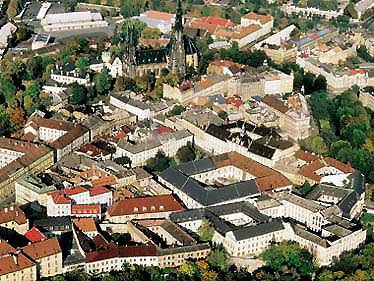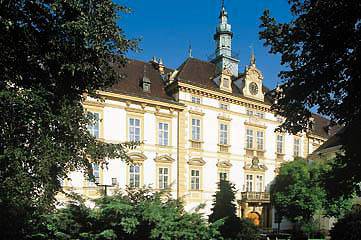Olomouc
< Informační centrum, Horní máměstí - radnice, 772 00 Olomouc
Informační centrum, Horní máměstí - radnice, 772 00 Olomouc
Tel. +420 585 513 385

The oldest part of the town now occupies the area on which formerly stood an eleventh century castle. In its place the royal clan of Přemyslovci built in about 1110 the Cathedral of St. Wenceslas. During its last reconstruction, tall spires in the new Gothic style were added to the cathedral. Historically valuable is the town's so-called Romance Palace. Only a wall now remains of the palace with the Romance style, two-part and three-part sectional windows. Their masterful rendition reflects a high level of artistry and craftsmanship.

The City Hall, formerly a mercantile house, dominates the spacious square. The house underwent adaptations as early as 1378. Following the substantial reconstruction at the beginning of the 17th century, the City Hall changed its appearance several more times, the last time in 1903. An astronomical clock is built into the alcove under the tower spire.
Another prominent feature of the square is the Baroque pillar of the Most Holy Trinity. The stony monument with the exceptionally elaborate figurative decorations was designed by Václav Render. In addition to this particular sculptor, others cooperated on the completion of the monument. Of these, Ondřej Zahner and Šimon Forstner contributed the most. The pride of the town is also a singularly beautiful set of water fountains with Baroque sculptures.

A number of exceptionally valuable buildings has been preserved in the centre of Olomouc. The church of St. Morris draws attention by its massiveness and prismatic spires. It contains an impressive triple-nave gallery and houses a Baroque organ with 10,400 pipes. Preeminent Baroque decorations enrich the interior of the church of St. Michael whose early Gothic predecessor was rebuilt by G. P. Tencalla in 1676 - 86. The power of the Jesuit order is reflected in the college buildings and the church of the Immaculate Virgin, which also attracts attention by its stunning construction and lovely interior decorations. Due to lack of space, a mention will be made here only of the Archbishop's Palace built in 1664 - 1674. The long-lasting governance by the Caesar Franz Josef I began here by his coronation in its Throne Hall.


 Informační centrum, Horní máměstí - radnice, 772 00 Olomouc
Informační centrum, Horní máměstí - radnice, 772 00 Olomouc Informační centrum, Horní máměstí - radnice, 772 00 Olomouc
Informační centrum, Horní máměstí - radnice, 772 00 Olomouc



